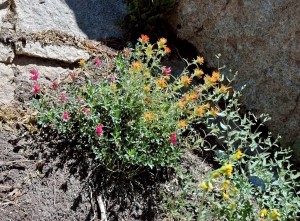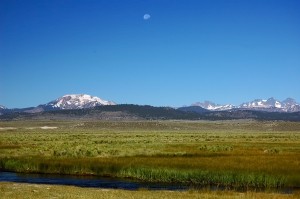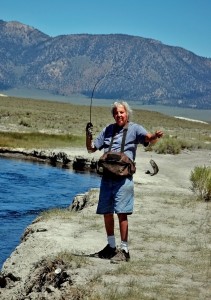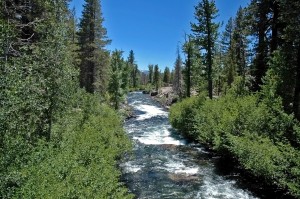We spent all of last week fishing, hiking, and generally enjoying the beauty of the Mammoth area while based in New Shady Rest Campground. The weather was perfect, and the fishing wasn’t far behind. Here are some updates on earlier blogs:
The Owens River
We fished the Owens below Benton Crossing twice while we were there and had good luck both times. The water was on the high side, but the river was very fishable. Even the moss that floats down the river wasn’t all that annoying.
On day one, I floated worms and caught 17 trout in less than an hour. I released all but five. The average rainbow was about 10 inches, but my limit ran larger after I let the little ones go free. I didn’t observe anything over 15 inches, but that doesn’t mean there weren’t larger fish in someone else’s creel.
On day two they had just planted and it was a wide open bite. I fished for 45 minutes and lost count of how many I let go.
The San Joaquin River
We fished the area between Devil’s Post Pile and Rainbow Falls twice. The river was running high and fast, and some of my usual holes were looking more like rapids. Still there were plenty of fish. The ones I caught ran on the small side between 6 and 12 inches. We caught an even mix of rainbows and browns, and we let all but one go free. This area should reach its peak potential about the middle of August when the snow melt eases up.
 We also took a nice flower hike getting off the bus at Agnew Meadows and following the Shadow Lake trail down to the river, and then turning left and following the river trail back to the Soda Springs campground. It’s an easy 5 mile long, mostly downhill walk with good scenic views for anyone who already has their limit of fish.
We also took a nice flower hike getting off the bus at Agnew Meadows and following the Shadow Lake trail down to the river, and then turning left and following the river trail back to the Soda Springs campground. It’s an easy 5 mile long, mostly downhill walk with good scenic views for anyone who already has their limit of fish.
Duck Lake Pass
One person in our party wanted to cross Duck Lake pass and go down to Duck Creek. He ran into heavy snow before he got to Skeleton Lake but still slogged as far as Barney Lake
just this side of the pass. He reported that the trail over the pass was completely hidden under snow, and that it probably won’t be back to normal until the middle of August or later. The creek should produce well as soon as the snow melt slows down and slower water allows you to work the deeper holes below the lake.
He did fish Barney, and he caught a nice limit of Brook Trout between 10 and 14 inches. The best fishing was in the little feeder pond just below the lake’s outflow.
We did several other hikes on this trip after icing our limits in a cooler full of snow early on. Another nice downhill hike is to park your car near the ranger station above the ski lodge, cross the road, and access the Starkweather trailhead that winds down to Starkweather Lake. It’s about three easy miles and offers a variety of scenic views and colorful flowers. There’s also an old abandoned gold mine about half way down. You can catch the bus back to your car from the lake.
All-in-all we had a good trip. The snow is melting fast so the water will remain high for a couple more weeks, but then it will be Mammoth back to normal. I love this area, and if you haven’t been there before try it, I’ll bet you end up loving it too.



